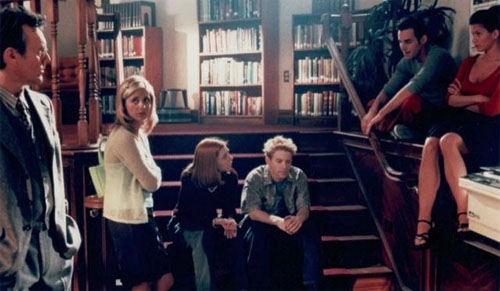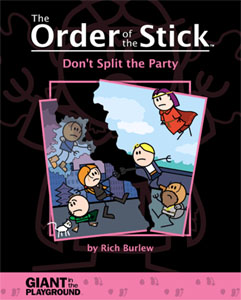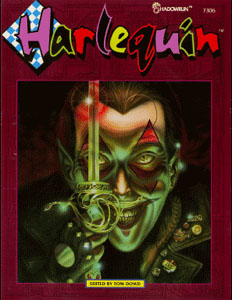Bangs are the explosive moments that define the agenda of a scene and force the PCs to start making meaningful choices. But you don’t necessarily need to come up with all of your bangs on the fly. In fact,  prepping bangs can be a very flexible and effective way to prep. In Sorcerer, Ron Edwards talks about prepping a bandolier of bangs. It’s a great image. The GM goes into a session armed with his bangs, ready to escalate and respond by hurling the material he’s prepared into the fray.
prepping bangs can be a very flexible and effective way to prep. In Sorcerer, Ron Edwards talks about prepping a bandolier of bangs. It’s a great image. The GM goes into a session armed with his bangs, ready to escalate and respond by hurling the material he’s prepared into the fray.
For example:
- Suzie calls. She’s pregnant.
- A death knight kicks down the door.
- Your muse starts howling. Your system is getting hacked by something ugly.
- A dark miasma creeps across the surface of the moon. The werewolves begin bleeding from their eyes.
Grab any of those and toss ‘em like a grenade.
SPOTLIGHT BANGS
Bangs force choices. If the choices forced by a particular bang – and the agenda it brings into play – are focused on a particular character, then the bang will shine a spotlight on them. One easy way to create a compelling session is to simply ask, “What interesting thing is going to happen to each of the PCs today?” Hit them with those bangs and then see what develops.
One technique for developing spotlight bangs is the flag. The idea here is that a player’s character sheet and background can tell you a lot about what they’re interested in: If they’ve handed you a PC decked out with investigation skills, you should probably be tossing them juicy mysteries. If their character background is drenched in orders of chivalry, they probably want to get involved with the royal knights. And so forth.
(Of course, this is more of an art than a science. Some times, for example, people put points into an activity not because they find it interesting but because they find it boring and would rather dispatch with it quickly. But those exceptions are rare and, when in doubt, you can just chat with them.)
KEYS
In The Shadow of Yesterday, Clinton R. Nixon introduces the concept of keys: These are motivations, problems, connections, duties, and loyalties that players select during character creation. For example:
Key of Bloodlust: Your character enjoys overpowering others in combat.
- Gain 1 XP every time your character defeats someone in battle.
- Gain 3 XP for defeating someone equal to or more powerful than your character.
- Buyoff: Be defeated in battle.
Key of the Mission: Your character has a personal mission that she must complete.
- Gain 1 XP every time she takes action to complete this mission (2 XP if action is successful).
- Gain 5 XP every time she takes action that completes a major part of this mission.
- Buyoff: Abandon the mission.
I’m going to genericize the term here and use key to refer to any mechanic or method of character creation that formalizes the creation of flags. These mechanics allow the player to specifically say, “This is important. You should use this.” And when these mechanics exist, the GM needs to respond to them with key scenes: Opportunities for those keys to be turned.
Key mechanics are often called out in a lot of indie games from the past decade or so, but you can find these mechanics lurking all over the place. For example, the keys of The Shadow of Yesterday are mechanically almost identical to the “Individual Class Awards” found in the AD&D 2nd Edition Dungeon Master’s Guide. The rules for creating covenants in Ars Magica are similarly filled with mechanical cues for the GM to use.
KICKERS
In Sorcerer, Ron Edwards uses the concept of a kicker: A specific, life-altering bang that the player defines during the process of character creation and which basically happens at the moment that play begins: Their mother is murdered. They win the lottery. The village is burned to the ground. By getting the players involved in the creation of these “initiating bangs” you can give them a lot of agency in defining the shape the campaign will take. But even if you create the kickers independently, this is still a solid technique for getting the PCs involved in the campaign.
For example, one of the quickest ways to customize a purchased adventure is to figure out how to tie the initiating bangs of the adventure directly to the PCs (their interests, their cares, their goals). Once you’ve done that, everything else will flow naturally.
The kickers in Sorcerer are epic in nature because Edwards uses them to launch (and drive) entire campaigns, but the basic concept of the kicker can be used to create adventures on a smaller scale, too.
If you use an episodic approach in structuring your campaign, for example, you can set up your situation like a toolbox (see Don’t Prep Plots), and then figure out the big, effective bangs you can use to launch that situation into motion. You don’t have to do anything more than that. From that point forward, you can just react to what the players are doing.
In this guise it may become clear that you know kickers under a more common name: Scenario hooks. But the idea of hooking players into a scenario often seems to result in a limited palette: It’s the guy in the tavern who wants to hire them. Thinking about these hooks through the lens of the bang can help to expand your concept of what a “hook” really is. Instead of just thinking, “How can I make the PCs aware of this cool thing?” You can start thinking about how you can kick things off with a bang.
To put this more prosaically: There’s a tendency for scenario hooks to be delivered with a really weak agenda. (“Will they accept Bob’s job offer?”) Strong kickers means using hooks with more compelling agendas and higher stakes.
A TIMELINE OF BANGS
Of course you don’t have to limit your prepared bangs to the beginning of a session, either. One effective way of organizing prepared bangs is a simple timeline: Bang X happens at time Y. Other things may be happening in direct reaction to the choices made by the PCs, but the clock keeps ticking and the next bang that will complicate their lives keeps drawing inexorably closer.
I’ve also found that timelines are often a useful conceptual tool for people who are struggling to grok the concept of bangs in general. For example, here’s the timeline from an old campaign status document from my Ptolus campaign:
- 09/27/790: The PCs gain access to their Hammersong vaults.
- 09/28/790: Arveth uses the dais of vengeance on Tee.
- 09/28/790: A Pactlords strike team arrives at Alchestrin’s Tomb.
- 09/29/790: Maystra and Fesamere Balacazar approach the PCs. They want to hire them to break into the White House.
Some of these things are appointments the PCs have made. Others are ambushes. But every single one of them is a bang waiting to happen: When the clock reaches that moment, we’re going to frame a new scene, set an agenda, and bang our way into it.
(This is why I generally find it useful to keep two separate timelines in my campaign notes: One for stuff that’s generally happening in the background and one for stuff that’s going to directly affect the PCs.)
One other thing to note about these timeline entries, though: They aren’t fully-formed bangs. They’re more like bullets that are waiting to be fired. When the moment arrives, the actual bang will be customized to the circumstances of the PCs.
For example, if the PCs are at home when Maystra and Fesamere come looking to hire them, then the bang happens when the well-known members of a criminal family that bears them a grudge come walking through the door. If the PCs aren’t at home, then the bang happens when they come home and find the letter that was left for them.
BANGING ON THE TABLE
Another form of prepared bang which is often not thought of as such is the random encounter.
I’ve talked in the past about the effect OD&D’s 1 in 6 chance per turn of generating a random encounter has on dungeon exploration. If you think of each random encounter as a bang, the net effect of this system is to automatically deliver a steady pace of them. (This is another example of how the classic dungeoncrawl structure delivers effective pacing in the hands of neophyte GMs.)
One problem with this form of bang, however, is that it is so often just the same bang (“A WILD POKEMON APPEARED!”) leading to the same agenda (“Can you defeat the wild Pokemon?”). As I described in Breathing Life Into the Wandering Monster, you can solve that problem by finding new ways to contextualize the encounter.
For example, if you generate a random encounter of “8 skeletons” you can go for the predictable bang by saying, “You see eight skeletons and they attack you.” You can enrich that by varying the bang and saying, “From within the sarcophagi to either side, you hear the sounds of bone scratching against stone.” Or you can switch it up by changing the agenda and saying, “You see eight skeletons. They are arrayed around some huge mechanism of wooden gears. Some of the skeletons are pulling at levers, others are pushing on wheels.”
OD&D accomplished agenda shifts mechanically through the use of random reaction tables. Judges Guild applied similar techniques to urban encounters, separating the generation of what you were encountering from how and why you were encountering them.
BANG, BANG, BANG GOES THE RAILROAD
One risk in preparing specific, evocative bangs before play begins is that it can encourage railroading. (Or directly create it depending on the techniques employed.) A few tips for avoiding this:
First, bangs should never dictate a character’s response. In fact, as I’ve mentioned before, the best bangs are the ones that provoke the most choices. Note the subtle distinction between:
- “Saving the princess” / “Discovering that the princess is trapped”
- “Killing the wolf” / “Hearing the wolf howl”
- “Escaping the police” / “Hearing the police sirens pull up outside”
Second, as I described in my use of timelines above, you can often prepare bullets instead of bangs. These half-formed bangs can be quickly actualized during play based on the current circumstances of the PCs.
Third, don’t over-prepare the bangs. As the name implies, bangs are supposed to be short and sweet in any case. If you’re writing more than a sentence or two about your cool ideas for bangs, you’re probably investing too much in them. Invest less time in bangs (which will make it easier to let them go if the players go a different direction) and invest more time in preparing the toolbox of your scenario.
At the beginning of this I talked about having a bandolier of bangs: Bandoliers give you explosive options, but the stuff in the bandolier isn’t loaded. You haven’t pulled the pins. The bangs are there and ready and waiting for you; but when you pull them and how you pull them and where you throw them is stuff that gets discovered during play.
Boom.

 GMs tend to frame to the arrival: If the PCs are heading to a warehouse, the GM will cut to their car pulling up outside the warehouse. If they’re going to question a suspect, the GM will cut to them knocking on the suspect’s door. It’s a safe choice, but it’s frequently unnecessary. For example, if you know that the PCs are going to Boss Man’s office to search for clues, you don’t have to go through the laborious process of having them enter the office building, pick the lock on his door, and so forth. Instead, you can cut straight to them rifling through his filing cabinets and pulling out the incriminating documents.
GMs tend to frame to the arrival: If the PCs are heading to a warehouse, the GM will cut to their car pulling up outside the warehouse. If they’re going to question a suspect, the GM will cut to them knocking on the suspect’s door. It’s a safe choice, but it’s frequently unnecessary. For example, if you know that the PCs are going to Boss Man’s office to search for clues, you don’t have to go through the laborious process of having them enter the office building, pick the lock on his door, and so forth. Instead, you can cut straight to them rifling through his filing cabinets and pulling out the incriminating documents.













